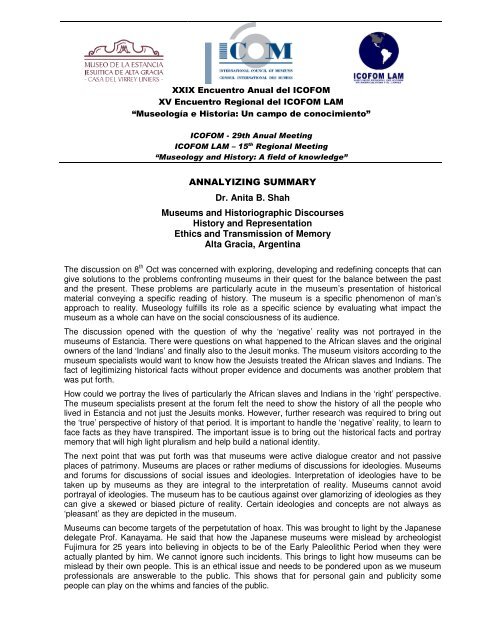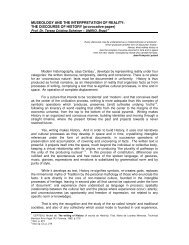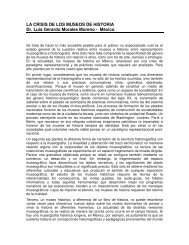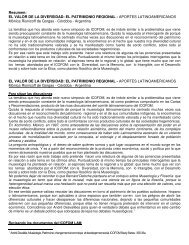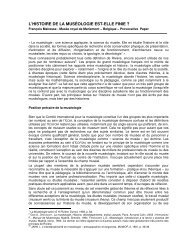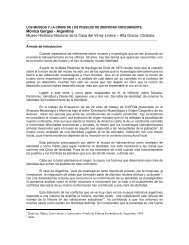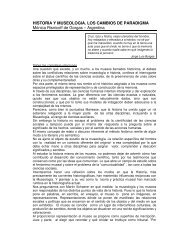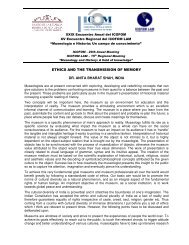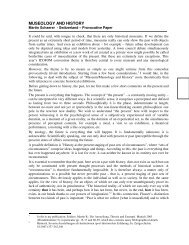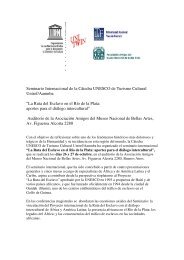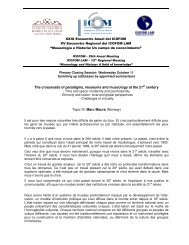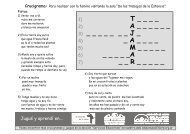ANNALYIZING SUMMARY Dr. Anita B. Shah Museums and ...
ANNALYIZING SUMMARY Dr. Anita B. Shah Museums and ...
ANNALYIZING SUMMARY Dr. Anita B. Shah Museums and ...
You also want an ePaper? Increase the reach of your titles
YUMPU automatically turns print PDFs into web optimized ePapers that Google loves.
XXIX Encuentro Anual del ICOFOM<br />
XV Encuentro Regional del ICOFOM LAM<br />
“Museología e Historia: Un campo de conocimiento”<br />
ICOFOM - 29th Anual Meeting<br />
ICOFOM LAM – 15 th Regional Meeting<br />
“Museology <strong>and</strong> History: A field of knowledge”<br />
<strong>ANNALYIZING</strong> <strong>SUMMARY</strong><br />
<strong>Dr</strong>. <strong>Anita</strong> B. <strong>Shah</strong><br />
<strong>Museums</strong> <strong>and</strong> Historiographic Discourses<br />
History <strong>and</strong> Representation<br />
Ethics <strong>and</strong> Transmission of Memory<br />
Alta Gracia, Argentina<br />
The discussion on 8 th Oct was concerned with exploring, developing <strong>and</strong> redefining concepts that can<br />
give solutions to the problems confronting museums in their quest for the balance between the past<br />
<strong>and</strong> the present. These problems are particularly acute in the museum’s presentation of historical<br />
material conveying a specific reading of history. The museum is a specific phenomenon of man’s<br />
approach to reality. Museology fulfills its role as a specific science by evaluating what impact the<br />
museum as a whole can have on the social consciousness of its audience.<br />
The discussion opened with the question of why the ‘negative’ reality was not portrayed in the<br />
museums of Estancia. There were questions on what happened to the African slaves <strong>and</strong> the original<br />
owners of the l<strong>and</strong> ‘Indians’ <strong>and</strong> finally also to the Jesuit monks. The museum visitors according to the<br />
museum specialists would want to know how the Jesuists treated the African slaves <strong>and</strong> Indians. The<br />
fact of legitimizing historical facts without proper evidence <strong>and</strong> documents was another problem that<br />
was put forth.<br />
How could we portray the lives of particularly the African slaves <strong>and</strong> Indians in the ‘right’ perspective.<br />
The museum specialists present at the forum felt the need to show the history of all the people who<br />
lived in Estancia <strong>and</strong> not just the Jesuits monks. However, further research was required to bring out<br />
the ‘true’ perspective of history of that period. It is important to h<strong>and</strong>le the ‘negative’ reality, to learn to<br />
face facts as they have transpired. The important issue is to bring out the historical facts <strong>and</strong> portray<br />
memory that will high light pluralism <strong>and</strong> help build a national identity.<br />
The next point that was put forth was that museums were active dialogue creator <strong>and</strong> not passive<br />
places of patrimony. <strong>Museums</strong> are places or rather mediums of discussions for ideologies. <strong>Museums</strong><br />
<strong>and</strong> forums for discussions of social issues <strong>and</strong> ideologies. Interpretation of ideologies have to be<br />
taken up by museums as they are integral to the interpretation of reality. <strong>Museums</strong> cannot avoid<br />
portrayal of ideologies. The museum has to be cautious against over glamorizing of ideologies as they<br />
can give a skewed or biased picture of reality. Certain ideologies <strong>and</strong> concepts are not always as<br />
‘pleasant’ as they are depicted in the museum.<br />
<strong>Museums</strong> can become targets of the perpetutation of hoax. This was brought to light by the Japanese<br />
delegate Prof. Kanayama. He said that how the Japanese museums were mislead by archeologist<br />
Fujimura for 25 years into believing in objects to be of the Early Paleolithic Period when they were<br />
actually planted by him. We cannot ignore such incidents. This brings to light how museums can be<br />
mislead by their own people. This is an ethical issue <strong>and</strong> needs to be pondered upon as we museum<br />
professionals are answerable to the public. This shows that for personal gain <strong>and</strong> publicity some<br />
people can play on the whims <strong>and</strong> fancies of the public.
Another important issue that was brought to light was the exhibition of the dead bodies. The<br />
mummies of three children of Llullaillaco in the Salta Province of North West Argentina has opened a<br />
contriversy. There has been a continuing controversy since 1999 in Argentina regarding this issue.<br />
Original People from Argentina <strong>and</strong> Chile objected to the display of these objects as they are children<br />
<strong>and</strong> they have a symbolic relation <strong>and</strong> consider them symbolically consider them to be their<br />
ancestors. Ironically the Government of the Province of Salta seems to pay more attention to the<br />
mummies rather than to the living people of this community.<br />
In June 2006 The Peruvian society asked the Government of Peru to explain how the 150 mummies<br />
of Leymebamba museum leave the country to be exposed in Austria <strong>and</strong> Italy <strong>and</strong> Europe. The<br />
museum has to deal with these ethical issues also. Since then, the Peruvian legislators are working<br />
on an Act to prevent non authorized <strong>and</strong> non regulated cultural exhibitions on foreign l<strong>and</strong>s.<br />
This attitude totally disregards their right to live with what they have inherited, <strong>and</strong> their right to decide<br />
what is ‘good’ for them. Thus a sort of unseen hierarchy gets established between cultures, relegating<br />
them to relatively inferior positions.<br />
Thus museums have to deal with a whole lot of such issues that are sensitive.<br />
All these points lead us to the facts that how can museums deal with issues that are politically correct<br />
<strong>and</strong> incorrect. Time can change the values added to beliefs. Time can turn tables <strong>and</strong> once politically<br />
accepted issues can become politically incorrect. This is especially true of societies that are in the<br />
mode of transition. But museums have to address issues <strong>and</strong> not be scared about reaction it can<br />
generate. <strong>Museums</strong> have to be cautious but not afraid. The museum is a place for stimulating thought<br />
<strong>and</strong> emotion, it is different from a history book.<br />
Thus interpretation of reality <strong>and</strong> the transmission of memory with high ethical st<strong>and</strong>ards is not as<br />
simple as it may seem in the museum context. The learning gradient of experience, interpretation <strong>and</strong><br />
underst<strong>and</strong>ing is not a gradual one. Past <strong>and</strong> present experiences together with projected meanings<br />
interact to give a complex underst<strong>and</strong>ing. Expectations, past experiences of the visitors, projections<br />
<strong>and</strong> identifications are all implicated in the total museum experience. What the visitors bring with them<br />
<strong>and</strong> will take back, both have to be carefully pondered upon. The role of the museum is to build<br />
bridges <strong>and</strong> open dialogues between cultures working towards reducing ethnic strife at the same time<br />
preserving the delicate fabric of cultural diversity of mankind, thus enriching the quality of human life<br />
on earth.


